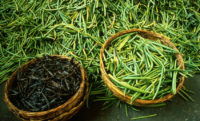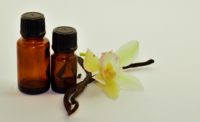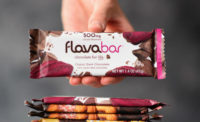If there are two things Eric Eslao enjoys, it’s chocolate and cannabis.
The former Apple marketing professional saw an opportunity to combine them in 2014, just as then-California Lt. Gov. Gavin Newsom began throwing support behind legalizing cannabis use in the state.
Eslao founded Défoncé Chocolatier, which now calls a 41,000-sq.-ft., Oakland-based edibles manufacturing facility — the largest in the world — home. In addition to producing high-end chocolate bars with low doses of THC (90 milligrams per package), the company also has the capability to produce truffles, panned items, gummies, hard candies, toffees and beverages.
Défoncé Chocolatier recently introduced chocolate-coated bites, with each containing 1 milligram of THC. Varieties include whole-roasted almonds, whole-roasted hazelnuts, whole blueberries and dark-roasted espresso beans.
And, in keeping with its low-dose philosophy, Défoncé has released two-square and eight-square boxes, with each perfectly-portioned square containing 5 milligrams of THC.
Eslao recently took some time to discuss how the skills he learned at Apple apply to his edibles business, the legal status of CBD and his dedication to precision in dosing and quality.
What led you to found Défoncé Chocolatier?
Being a big fan of cannabis, but more so a big fan of chocolate, it felt like it was a great opportunity to merge those two and come up with a great product. It was really a love for chocolate and a love for cannabis and marrying the two together.
What was your role with Apple and how could you apply that to Défoncé?
What I was able to leverage from Apple to starting Défoncé was the attention to detail, attention to the consumer experience, really focusing on making sure we get good inputs, whether it’s ingredients, people, anything.
I’ve seen it happen over and over with people who have left Apple and started a company. You really feel the trend line from what they’ve taken from Apple and applied it to their other hardware or software companies, or in this case, edibles.
How did you get the ball rolling on this? Did you reach out to a consulting firm? Or did you start making samples in your kitchen?
We were friends with a couple people over at TCHO Chocolate, a chocolate company out of Berkeley. Louis Rossetto and Jane Metcalfe started it, they live in Berkeley. We met them, got introduced to some chocolatiers. We knew we wanted to commercialize this project. It wasn’t something that we were thinking to do on a small scale or just sell it to friends and family.
We went to people who have done this as part of their careers, rather than someone who would do it on the weekends or learn on their own as home chef. We really took it serious from the get-go. We wanted really serious professional chefs that make it make chocolate at a commercial level.
With the capability to produce all kinds of cannabis-infused products, do you do a lot of contract manufacturing?
It’s been more of function of the fact that we wanted to get Défoncé right in the same way that a lot of the equipment that is being used to develop and make the iPhone — to get that precise, get that type of quality they had to make machines specific for all the parts.
We took the same kind of direction. It was really important for us to be very precise with dosing, making sure we were precise with how the end-product looks so we don’t have as much loss. The fortunate part of that is we built an amazing factory with really good food manufacturing professionals. The output is Défoncé, but now we have the ability to do the same for other brands as well.
We’ve been very selective with us manufacturing products for other people. They have to have same mantra or ethos of quality first. It was more of a function of doing Défoncé really right and then we could add another vertical of revenue by manufacturing other brands.
How did you come up with the name Défoncé?
Défoncé is French. It means “high.” At the time when we started it, there weren’t a lot of sophisticated products. You’d still see brownies wrapped in foil with a printed label. We really liked the juxtaposition of the way it read, the way it sounded, to the meaning. A lot of our French friends found it really funny, so we went with it.
How do you source cannabis?
The great thing is that though there’s a lot of talk about some of these larger farms getting taken over, it’s still dominated primarily by boutique farmers who decided to grow special strains. We have our list of farmers that we like working with, in addition to the exactors that get the actual cannabinoid out of the plant. It’s really important to us now to maintain consistency but also support the farmers who got us here. From a corporate standpoint, from a sustainability standpoint, it made a lot of sense on many fronts.
Do you work with cocoa farmers or do you purchase chocolate?
We already have the most difficult function of infusing the chocolate with cannabis, so we didn’t want to complicate the process by going bean-to-bar. Understanding how difficult it is, we’ve left getting the cacao and processing it to the professionals.
Défoncé’s products are made with THC. Would you ever consider making edibles with cannabidiol (CBD), a nonpsychoactive cannabinoid?
There are two different types of CBD. With CBD from cannabis, we definitely have that in our pipeline. Within the legal framework, we can sell products with CBD from cannabis within dispensaries and there are no changes to our business.
What has been in contention at the state and federal level is edibles made with CBD derived from hemp. As of right now, with the attorney general of California and the California Department of Public Health — even with the passing of the Farm Bill — there’s been no change in their viewpoint of edibles from hemp. You just can’t do it. It would be under the purview of the FDA. With us wanting to be a good actor in the cannabis space and being very respectful of the regulators, we’re just abiding by the regulations and the attorney general’s viewpoint of CBD derived from hemp vs. cannabis.
How did you develop the packaging of your products?
There’s a lot of quality chocolate on the shelves of Whole Foods, and we used a lot of the products that we loved personally as inspiration. We’ve had some proprietary ways of doing it, and we also use out-of-the-box solutions. What’s considered child-resistant packaging is evolving, so we’re going to stay on top it, stay ahead of any those changes and make sure we’re in compliance.
How would you describe your typical consumer?
Anybody who likes quality and isn’t looking at potency versus of the cost of our chocolate. The quality products that are selling for more are getting more popular, with the reason being a lot of new consumers are bringing the habits that they have when it comes to purchasing produce or purchasing coffee and bringing it to the cannabis space.
To new consumers, edibles are by far the easiest to understand. There’s no paraphernalia. You take out the edible, you eat the edible and you wait 30 to 50 minutes for feel the effect. It’s very different from buying flower and having to roll a joint. It’s a very attractive solution.
How did Défoncé get involved with St. Jude?
This is a personal cause for us. We have a 2-year-old and a 1-year-old. We just wanted to able to provide donations from the company. I really like the organization and what they do. Having kids and being a parent, it made a lot of sense for us.









